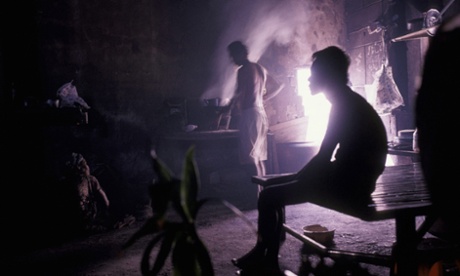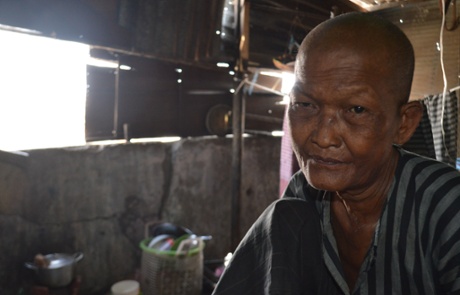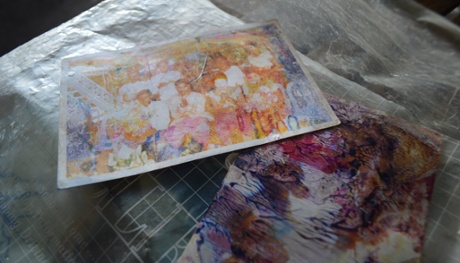Inside the famous Phnom Penh cinema that has become a living nightmare
The
Hemakcheat was once one of Cambodia’s most beloved cinemas and Meas
Sopheap one of its star dancers. Today it is a notorious slum, and Meas
one of hundreds who shelter there
The Guardian | 23 July 2014

In early summer, as the rainy season approaches Phnom Penh, the
faintest wind shakes Meas Sopheap’s home – a creaky shelter in the
once-grand building. Water seeps through the roof, fashioned from
plastic sheets and corrugated iron, into a mound of sodden rubbish
underfoot. At 87, her body bears the scars of an untreated skin disease
and she scratches herself constantly as she tells her story.
A few decades ago Meas Sopheap was a star, and the Hemakcheat was one of the country’s most beloved cinemas.
“I
was beautiful at that time, maybe you want to see,” she says, searching
through a plastic binder for two old photographs – relics that pre-date
the genocidal Khmer Rouge regime, which seized power in 1975 and banned
personal property. “Before the Pol Pot regime arrived, there were many
people in the city and we were very happy,” she continues, referring as
many Cambodians do to the Khmer Rouge era by the name of its leader.
The years between 1960 and 1975 are sometimes referred to as the country’s cultural golden age. Hundreds of Cambodian films were produced: tales of royalty and magic including several amateurish efforts by the charismatic King Norodom Sihanouk. New Khmer architecture, Asia’s answer to Bauhaus, was born. The Hemakcheat, a brutalist-style building that could seat 1,000-plus theatregoers, was a prime example.

Today the cinema is a notorious slum, one of more than 300 in the
capital. Hundreds of men, women and children shelter here, many on the
ground-floor auditorium where they are shrouded in permanent darkness
among hundreds of bats that screech and flap their wings constantly.
Children play on rickety staircases. Dirty water drips from the ceiling
and soaks into a towering, stinking mound of rubbish. More waste falls
from makeshift floors constructed above. The rotten stench of sewage is
overpowering.
Many Hemakcheat residents have spent most of their
lives in the building; a few remember the years before the communist
era. In those days, Meas performed in the Cambodian dance-drama Lakorn Basak
at home, abroad and on film, as well as on the Hemakcheat stage, where
she was friendly with the owners. It was an anxious but exciting time:
even as Khmer Rouge soldiers surrounded the city, the actors partied and
the cinema doors stayed open.
Those who had money or connections
fled overseas, many to France. Meas was offered the opportunity but
turned it down to stay close to her family. It was a fateful decision:
the Khmer Rouge seized power and Meas was trapped. These Maoists, who
believed in the superiority of rural ‘original people’ to ‘new’
urbanites, closed the cinemas and emptied the capital. The city’s
inhabitants were forced out to labour in the fields.
Four years passed, during which a quarter of the population was executed or died
from starvation or illness. When the regime finally fell in 1979, many
survivors returned to their homes to find them occupied. Phnom Penh was
slowly repopulated, buildings occupied on a first-come-first-served
basis. Latecomers made their home in slum settlements like the
Hemakcheat, which had weathered the regime.
Among them was Hong
Thavy, who had known the cinema as a little girl. Today the 44-year-old
lives on the fourth floor of the building and sells groceries to support
her own gaggle of small children.“When the Pol Pot regime finished, I
came back to Phnom Penh and this place was free and clean,” she says, as
her young brood tuck in to a lunch of tiny crabs. “There weren’t many
people living here, maybe just three or four families. But after four or
five years, more people came.”
Meas arrived in the early 2000s.
After the regime fell, she returned to her home province of Prey Veng,
but was evicted when a private company took the land and her husband
left her. She decided to come back to the place she had been happiest.
“I used to live in Phnom Penh; I had a lot of food to eat and enjoyed
the sights,” she says, adding: “I could not live in the rural areas.”
Others had the same idea – but as the population grew, so did the
squalor.

On the old cinema’s ground floor, where 44-year-old Ek Sopheap lives
in a palm-thatch home that she rents for $30 per month, the stench of
urine and alcohol is inescapable. One toilet is shared between all the
families and the door is frequently left open. “Now there are many
people living here and they just throw the rubbish down,” she says. “The
water they use in the kitchen drips down too, so it’s a very bad smell
and it is difficult for me to breathe.” Ek has given birth to 13
children, all but four of whom died within days of being born.
Ask
most Hemakcheat residents what they need and they say medicine.
Inhabitants suffer from a host of life-threatening diseases including
HIV/Aids, diarrhoea and tuberculosis. Drug addiction is rampant. But
residents receive little assistance. A spokesman for the Phnom Penh
municipality said they take no responsibility for the Hemakcheat, and
hold no information about it.
Hanging over the heads of residents is the spectre of forced eviction.
There are frequent rumours that the Hemakcheat building is about to be
sold – to a foreigner, or a local businessman, depending on the week.
(Only one of the city’s old cinemas remains in state hands, according to
the director of the cinema department at the Ministry of Culture and
Fine Arts.) There are fewer slums in Phnom Penh today than there were
five years ago, according to a March report,
but little is said about the people who have been evicted to make way
for new developments. Some of the settlements have simply vanished, the
whereabouts of their former inhabitants unknown.
Sinn Sisophan,
who lives on the ground floor of the Hemakcheat, was a cyclo rickshaw
driver until 1993 when a car careened into him and left him without use
of one of his legs. It was the kind of accident that demonstrates the
chasm between rich and poor, as the city’s wealthiest residents drive
$500,000 4x4s while the rest make do with bicycles and scooters. Sinn
believes the crash was deliberate: “They discriminate between the rich
and poor people,” he says.
A car crash also crippled Meas after
she moved back to Phnom Penh and began working as a garbage collector.
Begging on the street, she sees a city where life is improving for the
few: “I think that it’s better, but not for me – for other people,” she
says.

At last, Meas finds the two old photographs she had buried in the
ground during the Khmer Rouge regime. Rainwater has soaked through, and
they are stuck together. Prising them apart, the colours have bled into a
kaleidoscopic swirl of oranges, pinks and purples. It doesn’t seem to
bother Meas.
“I’m the one in the middle,” she says, pointing
to an elegantly dressed woman with her hands pressed together. It’s her
wedding day in the early 1940s, and she is seated beside her
husband-to-be. The picture has survived much of the trials of the
country’s recent history, but the last few years have been too much to
bear. In place of a smile is a blank space where her face has been
washed away.


No comments:
Post a Comment